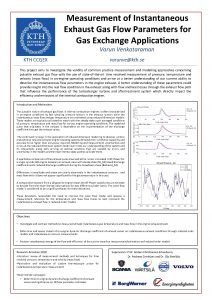Measurement of Instantaneous Exhaust Gas Flow Parameters for

- Slides: 1

Measurement of Instantaneous Exhaust Gas Flow Parameters for Gas Exchange Applications Varun Venkataraman KTH CCGEX varunve@kth. se This project aims to investigate the validity of common practice measurement and modelling approaches concerning pulsatile exhaust gas flow with the use of state-of-the-art time resolved measurement of pressure, temperature and velocity (mass flow) in on-engine operating conditions and arrive at a better understanding of our current ability to describe the instantaneous flow parameters in the engine exhaust. A better understanding of these parameters could provide insight into the real flow condition in the exhaust along with flow and heat losses through the exhaust flow path that influence the performance of the turbocharger turbine and aftertreatment system which directly impact the efficiency and emissions of the internal combustion engine. Introduction and Motivation: The pulsatile nature of exhaust gas flows in internal combustion engines is often characterised in on-engine conditions by fast sampling pressure sensors in the exhaust runners while the instantaneous mass flow and gas temperature are estimated using reduced dimension models. These models are typically calibrated to match with the steady-state cycle averaged conditions of pressure, temperature and mass flow for various engine operating conditions. The modelled pulse that originates in the exhaust is dependent on the implementation of the discharge coefficient through the exhaust valves. The continued increase in the application of reduced dimension modelling to develop, control and optimise new and complex engine-boosting systems demands their predictive capability and accuracy to be higher than previously required. Modelling and measurement uncertainties and errors at the reduced dimension system model level limits our understanding of the system and its interactions along with arriving at optimal solutions that are skewed by errors and uncertainty in the models and the experimental data used to calibrate them. A qualitative comparison of the exhaust pulse observed at the runner simulated in GT-Power for a single-cylinder HD engine between an exhaust valve with steady state (SS_Cd) based discharge coefficient and a reduced discharge coefficient during the blowdown phase (Reduced_Cd). Differences in amplitude and phase are clearly observable in the instantaneous pressure and mass flow while it does not appear significant for the gas temperature in this case. A comparative example from a LD gasoline engine shows the GT-Power based pressure estimate to deviate from the experimental observations for two different cylinder banks. The valve flow model is considered to be a significant factor for these deviations. These deviations necessitate the need to improve the valve flow model and possess a measurement reference for the temperature and mass flow traces to best represent the instantaneous exhaust flow in reduced order models Objectives: • Investigate and contrast methods to measure/estimate instantaneous gas temperature and mass flow in the engine exhaust stream • Determine and assess impact of on-engine dynamic discharge coefficient of exhaust valves on instantaneous exhaust conditions through reduced order models and instantaneous pressure measurements • Analyse instantaneous exergy of the flow and efficiency of the turbine based on measurement/estimation and reduced order models Research Activities 2019: • Literature review of measurement methods and techniques for time resolved pressure, temperature and velocity (mass flow) • Fabrication and evaluation of custom thermocouple probe for instantaneous temperature measurement • Experimental campaigns: • Determine on-engine dynamic discharge coefficient of exhaust valves and significance on 1 D flow parameter estimates Supervisors: Prof. Anders Christiansen Erlandsson, Dr. Andreas Cronhjort and Dr. Ola Stenlåås

